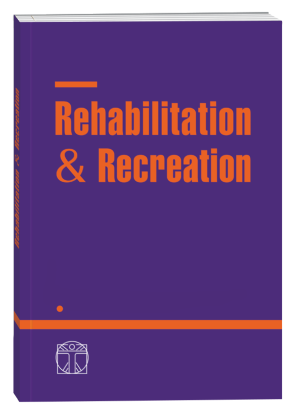DYNAMICS OF THE LEVEL OF RISK OF FALLS IN ELDERLY PATIENTS AFTER LAPAROSCOPIC CHOLECYSTECTOMY AT THE SUBACUTE STAGE OF REHABILITATION
DOI:
https://doi.org/10.32782/2522-1795.2023.17.5Keywords:
risk of falls, cholecystectomy, physical therapy, old age.Abstract
Aim. To determine the dynamics of the risk of falls in elderly patients after laparoscopic cholecystectomy (LCC) in the subacute period of rehabilitation under the influence of physical therapy. Materials. 80 elderly patients aged 60 to 74 years with chronic calculous cholecystitis (CCC) (n = 40), including (n = 31), men (n = 9) and patients with acute calculous cholecystitis (ACC) (n = 40), including women (n = 31) and men (n = 9), after LCC. The study is randomized and single-blinded. Patients with CCC: main group (OG1), control group (CG1); with ACC: OG2 and KG2. OG1 and OG2 patients receive rehabilitation intervention at the subacute stage of rehabilitation with a strategy to reduce the risk of falls. Methods. Berg’s balance test. Mathematical statistics methods: Student’s t-test for dependent and independent samples, significance level p<0.05. Results. The risk of falls according to the Berg test is considered to be less than 40 points, elderly patients after LCC of all groups in the subacute period had a risk of falls. At the first examination of the level of equilibrium, no statistically significant difference was found between the groups, including between the groups with CCC and ACC. The comparative characteristics of the test results of the groups before and after rehabilitation established a statistically significant difference when comparing groups KG1 and OG1 after; KG2 and OG2 after and when comparing the results of OG1 before and OG1 after; OG2 before and OG2 after the rehabilitation intervention, which indicates the effectiveness of the implemented strategy and means of reducing the risk of falls. Conclusions. Elderly patients after LCC of all groups at the beginning of the subacute stage of rehabilitation had a risk of falls. Patients in the control groups (CG1 and CG2) who had medical support, appropriate dietary guidelines, and exercise recommendations did not improve their balance function over 12 weeks. Balance results of OG1 and OG2 patients who received a rehabilitation intervention with a fall reduction strategy and engaged in a 12-week physical therapy program (36 classes) demonstrated an exit from the fall risk zone and a statistically significant (p < 0.05) improvement in results.
References
Moreland B., Kakara R., Henry A. Trends in Nonfatal Falls and Fall-Related Injuries Among Adults Aged ≥ 65 Years – United States 2012–2018.
MMWR. Morbidity and mortality weekly report. 2020. Vol. 69. № 27. P. 875–881. DOI: https://doi.org/10.15585/mmwr.mm6927a5.
Florence C.S., Bergen G., Atherly A., Burns E., Stevens J., Drake C. Medical costs of fatal and nonfatal falls in older adults. J Am Geriatr Soc. 2018. Vol. 66. № 4. P. 693–698.
Niemöller U., Tanislav C., Kostev K. Incidences for Fractures 2017-2021: What Do We Learn from the COVID-19 Pandemic? Healthcare (Basel, Switzerland). 2023. Vol. 11. № 20. P. 2804. DOI: https://doi.org/10.3390/healthcare11202804.
US Centers for Disease Control and Prevention Guidelines for Fall Risk. URL: https://www.cdc.gov/steadi.
Wiggins T., Markar S.R., Mackenzie H., Jamel S., Askari A., Faiz O., Karamanakos S., Hanna G.B. Evolution in the management of acute cholecystitis in the elderly: population-based cohort study. Surg Endosc. 2018. Vol. 32. № 10. P. 4078–4086. DOI: https://doi.org/10.1007/
s00464-018-6092-5.
Kohga A., Suzuki K., Okumura T., Yamashita K., Isogaki J., Kawabe A., Kimura T. Outcomes of early versus delayed laparoscopic cholecystectomy for acute cholecystitis performed at a single institution. Asian J Endosc Surg. 2019. Vol. 12. № 1. P. 74–80. DOI: https://doi.org/10.1111/ases.12487.
Golod N., Buhaienko T., Imber V., Kara S., Zastavna O., Prysiazhniuk O., Kravchuk M. The Results of the Examination of Patients After Laparoscopic Cholecystectomy in the Acute Period of Rehabilitation Using the International Classification of Functioning. Acta Balneologica.
Vol. 3. № 278. P. 222–229. DOI: https://doi.org/10.36740/ABAL202203104. URL: https://actabalneologica.eu/03-2022.
Голод Н.Р. Метод оцінки рухової дієздатності. Art of Medicine (Науково-практичний журнал). 2018. Vol. 4. № 4. С. 60–68.
Muehlbauer T., Gollhofer A., Granacher U. Associations Between Measures of Balance and Lower-Extremity Muscle Strength / Power in Healthy Individuals Across the Lifespan: A Systematic Review and Meta-Analysis. Sports medicine (Auckland, N.Z.). 2015. Vol. 45. № 12. P. 1671–1692. DOI: https://doi.org/10.1007/s40279-015-0390-z.
Sadeghi H., Jehu D. A., Daneshjoo A., Shakoor E., Razeghi M., Amani A., Hakim M. N., Yusof A. Effects of 8 Weeks of Balance Training, Virtual Reality Training, and Combined Exercise on Lower Limb Muscle Strength, Balance, and Functional Mobility Among Older Men: A Randomized Controlled Trial. Sports health. 2021. Vol. 13. № 6. P. 606–612. DOI: https://doi.org/10.1177/1941738120986803.
Lesinski M., Hortobágyi T., Muehlbauer T., Gollhofer A., Granacher U. Effects of Balance Training on Balance Performance in Healthy Older Adults: A Systematic Review and Meta-analysis. Sports medicine (Auckland, N.Z.). 2015. Vol. 45. № 12. P. 1721–1738. DOI: https://doi.org/10.1007/s40279-015-0375-y.
Borde R., Hortobágyi T., Granacher U. Dose-Response Relationships of Resistance Training in Healthy Old Adults: A Systematic Review and Meta-Analysis. Sports medicine (Auckland, N.Z.). 2015. Vol. 45. № 12. P. 1693–1720. DOI: https://doi.org/10.1007/s40279-015-0385-9.
Behm D.G., Muehlbauer T., Kibele A., Granacher U. Effects of Strength Training Using Unstable Surfaces on Strength, Power and Balance Performance Across the Lifespan: A Systematic Review and Meta-analysis. Sports medicine (Auckland, N.Z.). 2015. Vol. 45. № 12. P. 1645–1669. DOI: https://doi.org/10.1007/s40279-015-0384-x.
Gillespie L.D., Robertson M.C., Gillespie W.J., Sherrington C., Gates S., Clemson L.M., et al. Interventions for preventing falls in older people living in the community. Cochrane Database Syst Rev. 2012. №9. P. CD007146.
Tricco A.C., Thomas S.M., Veroniki A.A., Hamid J.S., Cogo E., Strifler L., et al. Comparisons of interventions for preventing falls in older
adults: a systematic review and meta-analysis. JAMA. 2017. Vol. 318. № 17. P. 1687–1699.
Phelan E.A., Aerts S., Dowler D., Eckstrom E., Casey C.M. Adoption of evidence-based fall prevention practices in primary care for older adults with a history of falls. Front Public Health. 2016. № 4. P. 190.
Casey C.M., Parker E.M., Winkler G., Liu X., Lambert G.H., Eckstrom E. Lessons learned from implementing CDC’s STEADI falls prevention algorithm in primary care. Gerontologist. 2017. Vol. 57. № 4. P. 787–796.
Stevens J., Smith M., Parker E., Jiang L., Floyd F. Implementing a clinically based fall prevention program. Am J Lifestyle Med. 2020. Vol. 14. № 1. P. 71–77. DOI: https://doi.org/10.1177/1559827617716085(0).
Johnston Y.A., Bergen G., Bauer M., Parker E.M., Wentworth L., McFadden M., et al. Implementation of the Stopping Elderly Accidents, Deaths, and Injuries Initiative in primary care: an outcome evaluation. Gerontologist. 2019. Vol. 59. № 6. P. 1182–1191. DOI: https://doi.org/10.1093/geront/gny101.
Florence C.S., Bergen G., Atherly A., Burns E., Stevens J., Drake C. Medical costs of fatal and nonfatal falls in olderadults. J Am Geriatr Soc. 2018. Vol. 66. № 4. 693–698.
Downloads
Published
How to Cite
Issue
Section
License

This work is licensed under a Creative Commons Attribution-NonCommercial-NoDerivatives 4.0 International License.












